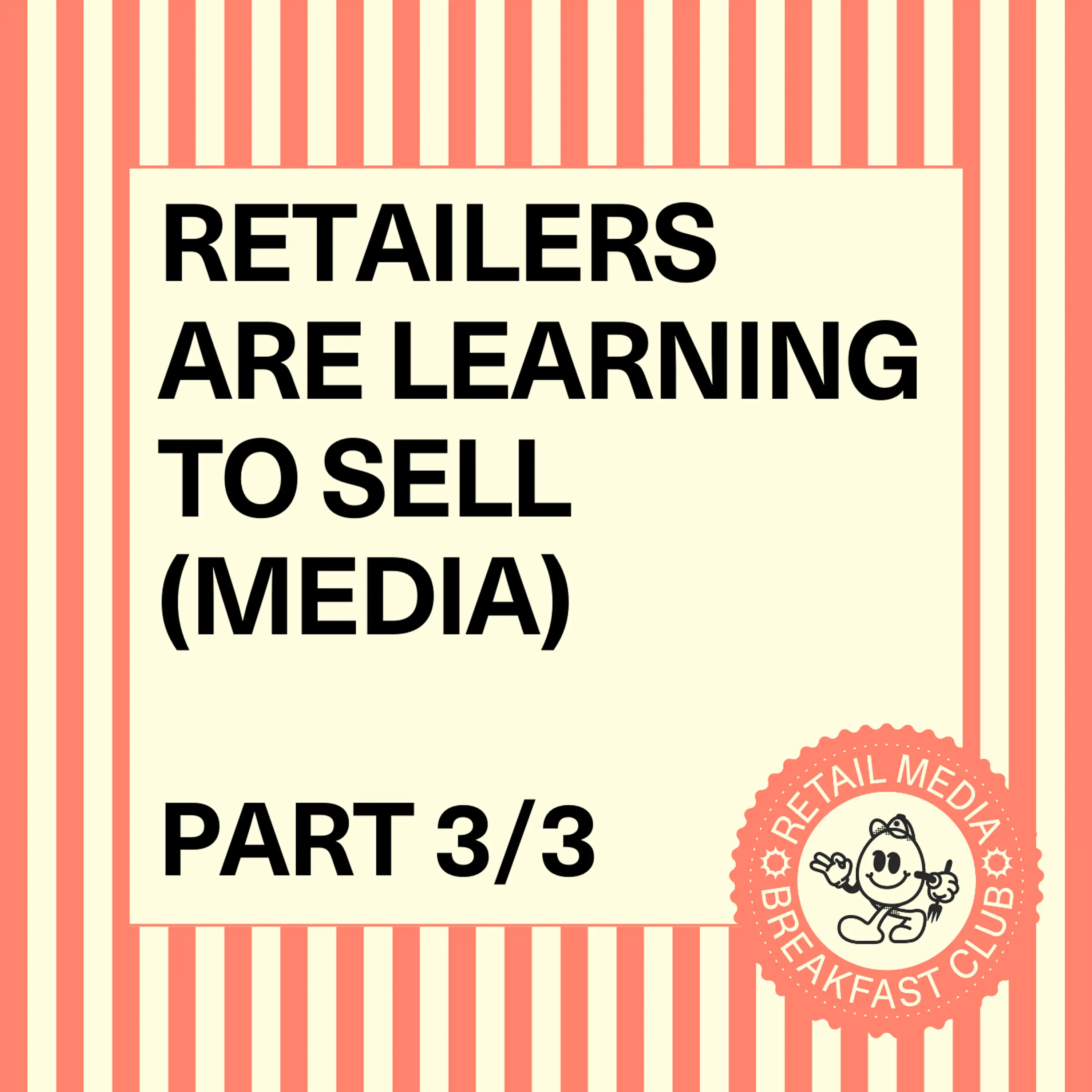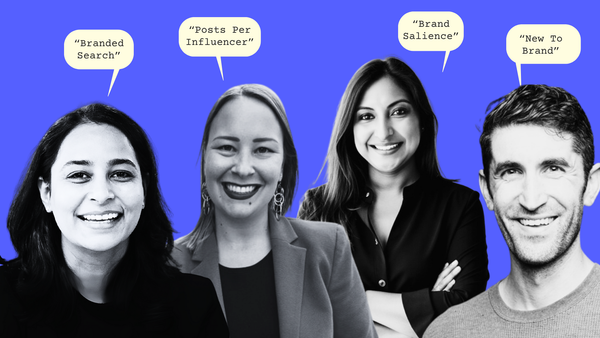Retailers Are Learning to Sell (Part 3/3): How Retailers and Media Buyers Can Work Better Together

Watch Episode Here
Listen to Episode Here
Show Notes
In this special 3-part series, Jordan Witmer, Managing Director of Unified Commerce at the agency Nectar First, joins Kiri to riff on the business of retail media from an advertiser, technology, and retailer perspective. we discuss about how retailers are jumping into the business of selling their ad inventory to brands. As they stand up these highly profitable properties, retailers need to grapple with a very "retail" challenge: their unique value proposition - but this time to advertisers rather than consumers.
In today's episode (the final episode of this miniseries), we discuss how retailers and media buyers can work better together, the need for transparency, and the importance of differentiation. Additionally, we explore the trend of self-service ad buying, highlighted by PepsiCo's recent move, and its implications for brands and retailers alike. Tune in for a deeper understanding of how retailers can collaborate more effectively with brands and optimize their media strategies.
Link to Jordan's LinkedIn profile: https://www.linkedin.com/in/jordan-witmer-b220b646/
Link to Nectar First: https://nectarfirst.com/
PRODUCED BY:
https://aipodcast.ing
CHAPTERS:
(00:00) About Today's Topic
(01:08) About the Show
(01:28) Introduction and Initial Thoughts
(01:45) Risks in Retail Media Networks
(03:09) Consumer Perspective on Retail Media
(05:24) Transitioning from Minor to Major League Retail Media
(07:13) PepsiCo's Move to Self-Serve Ad Buying
(07:54) Advantages of Self-Service for Brands
(08:45) Incentive Structures in Managed Service Setups
(10:20) Conclusion and Final Thoughts
(10:38) Outro
SOCIAL LINKS:
Website: https://www.retailmediabreakfastclub.com
LinkedIn: https://www.linkedin.com/in/kiri-masters/
YouTube: https://www.youtube.com/@retailmediabreakfastclub
Apple: https://podcasts.apple.com/us/podcast/retail-media-breakfast-club/id1782187624//
Spotify: https://open.spotify.com/show/3s5MuqcrsOmQDKn3uMYJKb
TRANSCRIPT:
Kiri: So we're back with Jordan Witmer, the managing director of unified commerce at the agency Nectar First. Previously, Jordan has been in senior e-comm and retail media positions at Kenvue, formerly J&J, Hershey, and Stanley Black & Decker. Jordan, we've spent a little bit of time the last two episodes from the brand point of view and how some of the setup on the retailer side can be confusing or feel a little obscuring. Let's take some time to look at this from the retailer's point of view and ultimately how retailers can work together in a more collaborative way with brands. But let's just start with their perspective here around retail media. This whole term has really sprung up in the last few years. We certainly weren't calling it retail media when I got started back in 2015. That really wasn't a thing. So what empathy do the retailers need around how they're building their networks and maybe why they might be a little reluctant to throw open the kimono on how their network is set up to begin with?
Jordan: And I know we talked before, we made the comparison to imagine this is their private label product. I think if we take that same lens and say, "Okay, now if I made public how I made that private level product, what risk am I taking on?" In this area in retail media networks, we're talking about risk of not being differentiated. So, I think if you go and make super public every component part of your media network, you do run the risk of an advertiser coming to you and saying, "This isn't different. I can get X, Y, Z on my own." And it starts to break down your value proposition. Which leads you to a pricing leverage issue. You risk more advertiser challenges on, "Okay cool, I can start to break down your CPMs or your CPCs because I know you're paying this vendor 10% and that vendor 20%, and I'm gonna start to back into what margin you're taking off the top." That gets very uncomfortable, and it gets down to a cost and transactional rather than a partnership. The third, I think, biggest risk that you would see or you would experience is competitive risk. If I'm starting Jordan's retail garage and I'm gonna build a media network and I tell everybody exactly how I did it, then when Kerry's retail garage starts and she wants to build her media network, she knows how my engine works. And be pretty easy to go build a faster car if you knew exactly how mine ran.
Kiri: I'm really glad that you're steel manning this 'cause it is very helpful. And so, I think to understand that might be the perspective on the retailer side. To that end, there's different reasons why we buy any product. It might be because I want some orange juice, and I might just love the Tropicana brand. I might be on the street and I need some orange juice now and it's about placement, so I can find it in a bodega or a convenient store. There's different reasons why we buy different things. For a brand buying retail media from a certain retailer, even if we understand the cost of the orange juice in the bottle is 50 cents and I'm paying $4.50, I don't have a choice. I'm not going to go pluck an orange off a tree and squeeze it myself. I need that orange juice. Then it's about which brand am I selecting when I walk into the convenient store? So, I get the point about the tech stack and if people understand what's in the tech stack, then they might understand what our cost is. I'm sorry, we all know that retail media's very profitable.
As a media buyer, we just wanna make it more easy and transparent for us. And good for you with your 80% profit margins on retail media. It is what it is. We already know that. So, I think it becomes about where else are you differentiating on? And it's obviously your audience, it's the relationship that we have with you and the whole package on the trade side as well that comes into a piece of it. So, super glad that you steel manned that argument, but I still think that the whole relationship would be significantly better off if there was a little bit more give on the side of the retailers around how things are set up and what a media buyer can expect from their tech stack.
Jordan: Yes, I made the arguments.
Kiri: You did very well. I know which side you're sitting on and you played the other side very well.
Jordan: I agree with where you're going. You and I had talked briefly before talked about that. How do we get to the next thing now that we know the orange juice is expensive, what's next? And that's where I'm really interested in talking through... It's a maturity stage thing. If you're an early stage RMN, chances are your advertisers aren't asking you these questions. The folks you're selling to haven't spent any time in ad tech. It does not benefit you in your first stage to disclose any of this. Doesn't help you, it's gonna confuse your partner that's buying this. I don't think they're doing the wrong thing to stay away from it.
It's, as you wanna make the transition from minor league to major league retail media, major league retail media looks different. It does look more like traditional media buying. It does look like the expectations are that you have an interoperable system. You make your inventory available wherever it is because you're differentiated in not the fact that you can control how much investment comes in. It's, to your point, I know more about my consumer. I can build you a better audience. I've got unique ad units or unique ways that you can deliver... there's a differentiation and uniqueness, it comes from a different place when you play the bigger game.
Kiri: I love that analogy, and I think you're so spot on. There are out of the box solutions, and there's, we can call it out, it's Criteo and CitriSad where they kind of do everything, and you can get started there and stand up a retail media network pretty simply with one vendor essentially. And then, as you say, going from minor to major league, you need to optimize on that stack a little bit and communicate why you've done that and what the benefit is to the advertiser. I love it. So one more thing before you go, Jordan. I know you've got some strong opinions on this one. Shifting gears a little bit, PepsiCo came out recently to say that they're moving only to self-serve ad buying, and it is relevant to this conversation in that some of these retail media networks-
Jordan: Definitely.
Kiri: Started out with a managed service, and that is a typical way to start out with a retail media network. Now that PepsiCo has come out and said that, I think it puts a little bit of pressure on retail media networks that don't have self-serve and that some are moving towards that model. What's your perspective from the brand side on the move to self-serve? Is this a universally held opinion on the brand side?
Jordan: At risk of my opinion being universally held, yes, absolutely. Everybody that's spent any time here can look at the system and say, "Okay, it's mature enough once your data's ready, it's in the right places." I don't get a lot of upside from managed service. A lot of times if you're, especially let's talk about the big advertisers that all have all of their dollars come from the bank of their hold co., and they can't extract that group from this transaction. So you're running managed service, you're paying two agencies to do it. You're paying a fee on the media spend for your agency to have this conversation with your managed service team at your retailer who's also taking a chunk out of your CPM. Self-service is, if nothing else, a huge boon benefit for working media dollars. Actually get to start working for your brand.
And I think the other big part of it for me in my past lives and why I coach everybody and anybody that'll listen towards self-service is people generally do what they're incentivized to do, and the incentive structure in a managed service set up is not the best, right? We've talked futility before, and what happens when you start putting up walls of who could see what, who makes what decisions, but you can very easily get to a place in the-
Kiri: Just to recap for people that didn't catch that, the incentive there is if you've got low performing ad inventory, you wanna sell it, and so you just kind of bundle it up and sell it as a package where it's not really visible that some ad units or some placements are not performing very well, you just kind of bundle it up and sell a, like the mortgage crisis. You bundle up all of the...
Jordan: It's not wrong.I think and the incentive question is real. And we've all seen it that have been buying in this space for a while is you hand off to a managed service team, they're trying to maximize dollars in for the media network. And if that means, I really have a bunch of this branded search traffic and I don't think anybody else is gonna buy it, we'll sprinkle a little bit of that into the plan. It'll be fine. And you get into these weird mixes of incentives of monetization on one side and yield management on that side, versus the actual best interest of you and your brand. I think between those two things, every major brand that I've spoken to is everybody is gathered behind the push of self-service.
Kiri: Well, we'll leave it there. Jordan, this has been great chatting with you about how retailers are becoming retailers again. Thank you for spending time with us. We'll link up to your LinkedIn profile and to Nectar First in the show notes, and thanks for joining us.





